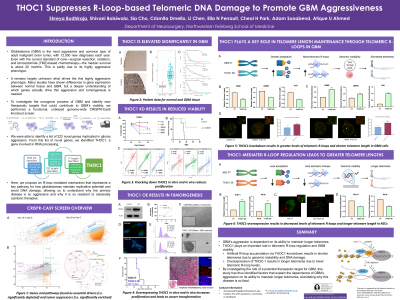THOC1 Suppresses R-Loop-based Telomeric DNA Damage to Promote GBM Aggressiveness
THOC1 Suppresses R-loop-based Telomeric DNA Damage to Promote GBM Aggressiveness
Friday, April 21, 2023


Shreya Budhiraja (she/her/hers)
Medical Student
Northwestern University Feinberg School of Medicine
Chicago, Illinois, United States
ePoster Presenter(s)
Introduction: Glioblastoma (GBM) is the most aggressive type of adult malignant brain tumor. To identify which genes drive its highly aggressive phenotype, we performed a genome-wide screen in GBM cells.
Methods: We conducted a whole-genome CRISPR-Cas9 knockout screen in a human GBM cell line over 28 days. Experiments to analyze the impact of top hits on viability and proliferation were conducted. In vivo models of GBM, using immunodeficient mice, were used to check survival benefit. Functional studies to understand the mechanism of action were pursued.
Results: THOC1, a previously unstudied gene in GBM, was identified as a top driver of GBM proliferation. THOC1 is involved in the prevention of R-loops, RNA:DNA hybrids that form normally during transcription, but may pose a threat to genomic stability when accumulated. Investigation into THOC1 showed significant survival benefit in patient datasets when downregulated (p < 0.05). Knocking out THOC1 resulted in cell death in multiple GBM patient-derived xenograft lines (p < 0.05). Treatment of mice bearing intracranial xenografts with THOC1-knockdown improved survival significantly (p < 0.01). THOC1-overexpression in neural stem cells resulted in transformation to a cancerous phenotype, as evidenced by soft agar assays (p < 0.01) and in vivo tumor engraftment assays. Additional investigation revealed that THOC1-knockdowns induced R-loop formation and DNA damage, while THOC1-overexpressions resulted in an untenable decrease in R-loop-mediated DNA damage, suggesting that THOC1 may be elevated in GBM to prevent genotoxic R-loop accumulation. RNA sequencing performed to identify transcriptional programs altered by THOC1-mediated R-loop prevention showed telomere regulation as a significantly enriched process (p < 0.01). Dot blotting of telomeric isolates further revealed that THOC1 protects telomere length and integrity through prevention of telomeric R-loop-based DNA damage in GBM (p < 0.01).
Conclusion : Here, we show a novel telomeric R-loop-mediated mechanism by which THOC1 may be responsible for promoting GBM aggressiveness, thus revealing a promising therapeutic target for GBM.
Methods: We conducted a whole-genome CRISPR-Cas9 knockout screen in a human GBM cell line over 28 days. Experiments to analyze the impact of top hits on viability and proliferation were conducted. In vivo models of GBM, using immunodeficient mice, were used to check survival benefit. Functional studies to understand the mechanism of action were pursued.
Results: THOC1, a previously unstudied gene in GBM, was identified as a top driver of GBM proliferation. THOC1 is involved in the prevention of R-loops, RNA:DNA hybrids that form normally during transcription, but may pose a threat to genomic stability when accumulated. Investigation into THOC1 showed significant survival benefit in patient datasets when downregulated (p < 0.05). Knocking out THOC1 resulted in cell death in multiple GBM patient-derived xenograft lines (p < 0.05). Treatment of mice bearing intracranial xenografts with THOC1-knockdown improved survival significantly (p < 0.01). THOC1-overexpression in neural stem cells resulted in transformation to a cancerous phenotype, as evidenced by soft agar assays (p < 0.01) and in vivo tumor engraftment assays. Additional investigation revealed that THOC1-knockdowns induced R-loop formation and DNA damage, while THOC1-overexpressions resulted in an untenable decrease in R-loop-mediated DNA damage, suggesting that THOC1 may be elevated in GBM to prevent genotoxic R-loop accumulation. RNA sequencing performed to identify transcriptional programs altered by THOC1-mediated R-loop prevention showed telomere regulation as a significantly enriched process (p < 0.01). Dot blotting of telomeric isolates further revealed that THOC1 protects telomere length and integrity through prevention of telomeric R-loop-based DNA damage in GBM (p < 0.01).
Conclusion : Here, we show a novel telomeric R-loop-mediated mechanism by which THOC1 may be responsible for promoting GBM aggressiveness, thus revealing a promising therapeutic target for GBM.
